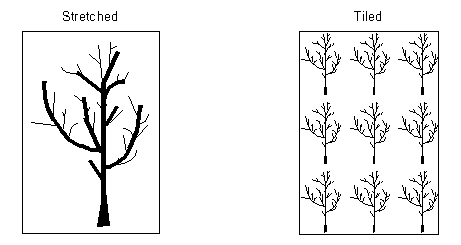L_UnderlayBitmap
Summary
Combines two bitmaps so that one appears to be an underlying texture for the other. This is most effective when the underlying image is a filtered one, such as an embossed image.
Syntax
#include "l_bitmap.h"
L_LTDIS_API L_INT L_UnderlayBitmap(pBitmapDst, pUnderlay, uFlags)
Parameters
pBITMAPHANDLE pBitmapDst
Pointer to the bitmap handle that references the bitmap to be used as the target image. This is the image that appears to be on top and retains its colors.
pBITMAPHANDLE pUnderlay
Pointer to the bitmap handle that references the bitmap to be used as the underlying image. This is the image that appears to be on bottom and is grayscaled as it is combined with the target image.
L_UINT uFlags
Indicators of how the underlying image is to be positioned. Valid values are:
| Value | Meaning |
|---|---|
| UB_TILE | [0x00] Tile the underlay. This repeats the underlying image, so that it fills the target image. This function does not do any resizing; you are responsible for the size of the tiles. |
| UB_STRETCH | [0x01] Stretch the underlay to fit the dimensions of the target image. |
Returns
| Value | Meaning |
|---|---|
| SUCCESS | The function was successful. |
| < 1 | An error occurred. Refer to Return Codes. |
Comments
This function changes the colors of the underlay to grayscale as it combines the images. It updates the target bitmap pBitmapDst, leaving the second bitmap pUnderlay unchanged. The underlying image can either be stretched or tiled to fill the target image, as shown in the following illustration:

To update a status bar or detect a user interrupt during execution of this function, refer to L_SetStatusCallback.
If a region is defined for the target bitmap, the underlay is applied to the region, not to the whole bitmap. (Any region defined for the underlay bitmap is ignored.)
Required DLLs and Libraries
- LTDIS
- For a listing of the exact DLLs and Libraries needed, based on the toolkit version, refer to Files To Be Included With Your Application.
Platforms
Win32, x64.
See Also
Functions
- L_CombineBitmap
- L_BumpMapBitmap
- L_CubismBitmap
- L_DrawStarBitmap
- L_DryBitmap
- L_FreePlaneBendBitmap
- L_FreeRadBendBitmap
- L_GlassEffectBitmap
- L_GlowFilterBitmap
- L_LensFlareBitmap
- L_LightBitmap
- L_OceanBitmap
- L_PlaneBendBitmap
- L_PlaneBitmap
- L_SampleTargetBitmap
- L_TunnelBitmap
- L_BendingBitmap
- L_CylindricalBitmap
- L_FreeHandShearBitmap
- L_FreeHandWaveBitmap
- L_ImpressionistBitmap
- L_PixelateBitmap
- L_PolarBitmap
- L_PunchBitmap
- L_RadialBlurBitmap
- L_RadWaveBitmap
- L_RippleBitmap
- L_SpherizeBitmap
- L_SwirlBitmap
- L_WaveBitmap
- L_WindBitmap
- L_ZoomBlurBitmap
- L_ZoomWaveBitmap
- L_AddShadowBitmap
- L_RevEffectBitmap
- L_AgingBitmap
- L_DiceEffectBitmap
- L_FunctionalLightBitmap
- L_PuzzleEffectBitmap
- L_RingEffectBitmap
- L_TextureAlphaBlendBitmap
- L_BricksTextureBitmap
- L_CanvasBitmap
- L_DisplaceMapBitmap
- L_FragmentBitmap
- L_VignetteBitmap
- L_CloudsBitmap
- L_ColoredBallsBitmap
- L_DiffuseGlowBitmap
- L_DisplaceMapBitmap
- L_FragmentBitmap
- L_HalfTonePatternBitmap
- L_MaskConvolutionBitmap
- L_MosaicTilesBitmap
- L_OffsetBitmap
- L_PerspectiveBitmap
- L_PlasmaFilterBitmap
- L_PointillistBitmap
- L_RomanMosaicBitmap
- L_ZigZagBitmap
Topics
- Raster Image Functions: Copying Images
- Processing an Image
- Applying Artistic Effects
- Raster Image Functions: Processing an Image
Example
For a complete sample code, refer to the CLRSPACE example.
L_INT UnderlayBitmapExample(L_VOID){L_INT nRet;/* This example uses TmpBitmap as a tiled underlay for LeadBitmap */BITMAPHANDLE LeadBitmap; /* Bitmap handle to hold the loaded image */BITMAPHANDLE TmpBitmap; /* Temporary bitmap *//* Load both bitmaps, at 24 bits per pixel */nRet = L_LoadBitmap(MAKE_IMAGE_PATH("Image1.cmp"), &LeadBitmap, sizeof(BITMAPHANDLE), 24, ORDER_BGR, NULL, NULL);if (nRet != SUCCESS)return nRet;nRet = L_LoadBitmap(MAKE_IMAGE_PATH("ULAY1.BMP"), &TmpBitmap, sizeof(BITMAPHANDLE), 24, ORDER_BGR, NULL, NULL);if (nRet != SUCCESS)return nRet;/* Use TmpBitmap as a tiled underlay for LeadBitmap */nRet = L_UnderlayBitmap(&LeadBitmap, &TmpBitmap, UB_TILE);if (nRet != SUCCESS)return nRet;nRet = L_SaveBitmap(MAKE_IMAGE_PATH("Result.BMP"), &LeadBitmap, FILE_BMP, 24, 0, NULL);if (nRet != SUCCESS)return nRet;/* Free the temporary bitmap */L_FreeBitmap(&TmpBitmap);L_FreeBitmap(&LeadBitmap);return SUCCESS;}
© 1991-2023 Apryse Sofware Corp. All Rights Reserved.
